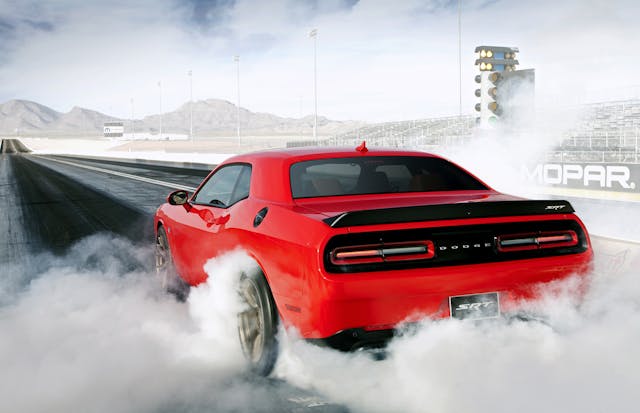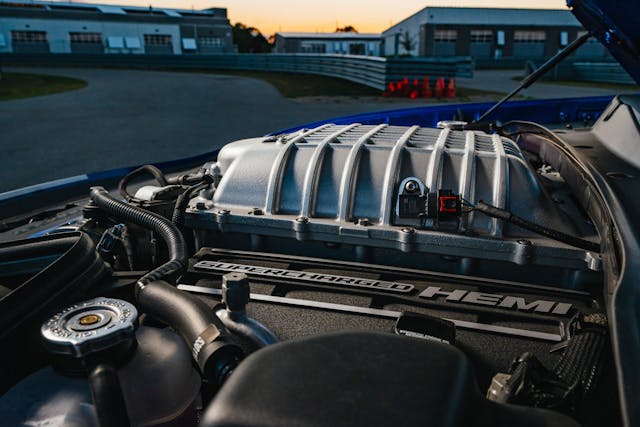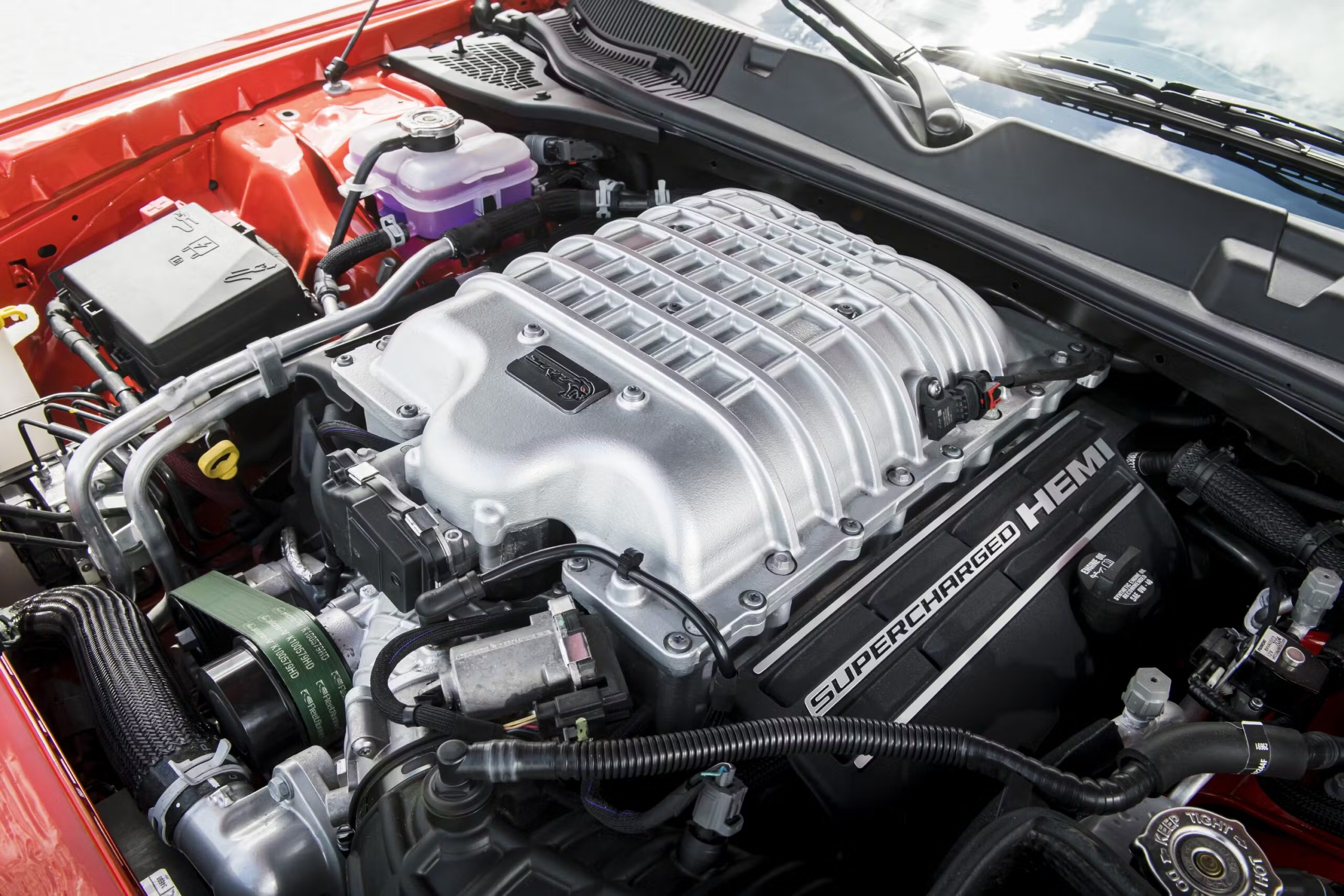Media | Articles
10 Hellcat engine facts you need to know
This year, 2023, is the final one of the Hellcat’s reign. Which one, you ask?
Ah, you’ve caught on.
If you ask Dodge reps, “Hellcat” refers only to vehicles made by Dodge, machines powered by a supercharged, 6.2-liter V-8.
On the street, though, “Hellcat” can refer to any vehicle powered by that engine. At press time, that count is just five: Three Dodges (two cars, one SUV), one Ram truck, and a Jeep. We drove all five. Many burnouts happened. You can read that whole story here.
Want to know more about what makes this engine so awesome?
Marketplace
Buy and sell classics with confidence
(Other than the fact that Stellantis has just kept building it, and putting it into vehicles, and making more of them, no matter what anyone else said?)
You’ve come to the right place.

1. Tolerance for pressure
If all eight of a Hellcat’s fuel injectors were aimed at a pint glass and run at max duty cycle, they would fill that glass in 7 seconds.
2. Sting like a bee
The standard Hellcat throttle butterfly is 92 millimeters in diameter. Just over 3.6 inches. No Stellantis or Chrysler engine has ever used anything larger. Well, except for the Challenger Demon 170‘s E85-swilling Hellcat. That version of the 6.2-liter Hemi got a cavernous 105mm throttle body.

4. Tighten the screws
That IHI supercharger, with its aluminum case, with its two air-to-water intercoolers built in, with its sealed-for-life oil supply, weighs 80 pounds. It can produce up to 11.6 psi of boost and move as much as 7900 gallons of air per minute. The intercoolers have their own dedicated electric pump for coolant.

5. Straight outta . . . Mexico!
Hellcat V-8s are built in a Stellantis plant in Saltillo, Mexico. Each 6.2 is run-in on a dynamometer for 42 minutes before being packed up and shipped out to a vehicle assembly plant.
6. Twist ’n’ shout
The 6.2’s “Hemi” engine family also includes a 5.7, a 6.1, and a 6.4. When the Hellcat Challenger was launched, the 5.7 offered a peak torque of 410 lb-ft at 4800 rpm. The Hell-Chally made that much at 1200.
7. Toughest on the block
The Hellcat block is cast-iron. Aluminum was considered during development but nixed. An alloy block capable of shrugging off 600-plus lb-ft likely would have been physically larger, harder to package, and more expensive.

8. Skrrt, skrrt
According to the genre-agnostic search engine at Lyrics.com, more than 3100 publicly released hip-hop and pop songs now contain the word “hellcat.” A quick survey of that search indicates that most of those songs reference a high-powered car. Which probably means they reference the Charger Hellcat sedan or its platform twin, the Challenger Hellcat coupe.

9. Left foot, stomp
Want this remarkable V-8 with a factory-installed clutch pedal? You are buying a Challenger Hellcat, and a used one at that. From 2015 to late 2021, that model was offered with a six-speed Tremec TR-6060 manual. All the rest—Charger, Durango, TRX, Trackhawk—were, and remain, two pedals only.

10. Jekyll and Hyde
Some Hellcat vehicles come with two types of key. The black fob, for valet use, detunes the car to 500 hp. The red fob gives the whole power enchilada.

11. Dyno juice
And a bonus fact, one more, because excess is the name of the game here: The Challenger Hellcat wears an 18.5-gallon fuel tank. Top that tank off and run the car at full power, it will be dry again in a mere 13 minutes.
***
Check out the Hagerty Media homepage so you don’t miss a single story, or better yet, bookmark it. To get our best stories delivered right to your inbox, subscribe to our newsletters.









Awesome, Awesome, Awesome, wish I could afford one but I’d likely get in trouble if I was behind the wheel of a Hellcat so I’ll just stick to my tired old MGB.
While the facts maybe interesting, I didn’t need to know any of them.
An amazing engine put in okay vehicles. If they were in better vehicles I would probably own one.
We are all dying to know what vehicles would meet your standards?
Ok Rick. What’s with the snide remarks today? Enough I say!
He’s trying to keep up with Merlin + Balke.
“Only” 500 HP in valet mode. Like that will keep the lot boys and girls from any antics.
Re #4: Never heard of air volume quantized in gallons. Is a gallon of air the same size as a gallon of milk? Seems more appropriate to say it in cubic feet at a given pressure (atmospheric I imagine) at a particular velocity (as in cu ft/min). Or maybe even take it to a molecular level and tell me how many moles of oxygen.
If it’s 0 Degrees out today and twice as cold tomorrow, how cold would it be?….my answer, Too Damn Cold ! HEMI….If it beats everything on the block, my hats off to every damn one of ya gals and guys at MOPAR….Thank You !
Why did you do a “10 Things ……. “ article, then leave out #3 and add a #11? Just to see if anyone would notice?
The last time i had a challenger-a1970 plum crazy 340 w/5.10:1 gears,i went from clean drivers license to 1 year suspension in 6 weeks!!
If you’re looking for the origin of the Hellcat name, go back to at least WW II when the Grumman F6F Hellcat flew off of aircraft carriers. And by the way, the only thing “Hemi” about these engines is the labeling. Apparently, Chrysler has a copyright on the name, something that actually meant something back in the ’60s when the sort-of-hemispherical combustion chambers made room for 2 big valves.